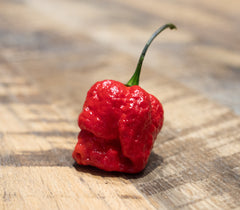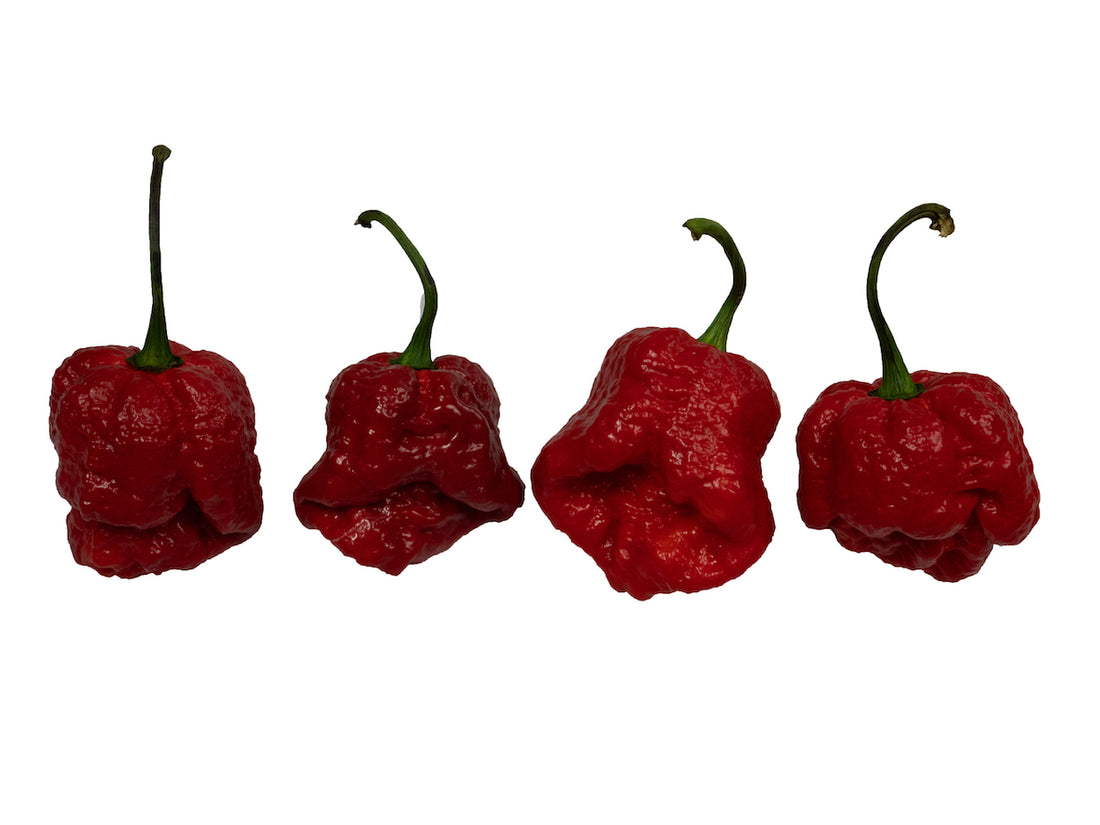A Complete Guide to the 2nd Hottest Pepper in the World
Table of Contents:
1. Scorpion Pepper Origin
2. How Hot is a Scorpion Pepper?
3. How to Grow Scorpion Peppers from Seed
3.1 Scorpion Pepper Growing FAQ
4. Scorpion Pepper Variations & Crosses
5. Scorpion Pepper Recipes
6. Pre-made Scorpion Pepper Snacks
7. Are Scorpion Peppers Worth Trying?
Are you into eating hot peppers with a sweat inducing, tongue vibrating heat that excites every endorphin in you while simultaneously leaving you speechless? How about growing exotic peppers from seed that will make one wicked hot sauce or instantly spice up a week’s worth of meals with delicious fruity pepper flavors?
No, I’m not talking about the Carolina Reaper.
I’m talking about the lesser known but similarly painful Moruga Trinidad Scorpion. A superhot pepper that’s uniquely delicious, versatile, and extremely fun to grow. In my opinion, it’s one of the most underrated superhot peppers out there.
Whether you’re looking to grow superhot peppers from seed, try new superhot pepper recipes, or challenge your “tough” friends to a superhot food eating challenge – the appropriately named Scorpion pepper is one that you need to try at least once.
Trinidad Scorpion Pepper Origin & History

If you're a geography buff it will come as no surprise that the history of the Moruga Trinidad Scorpion begins in Trinidad and Tobago, a small Caribbean Island off the northeastern coast of Venezuela. On the southern tip of this island there’s an area known as the Moruga district. It was here that a guy named Wahid Ogeer first developed the hot weather loving pepper known today as the Moruga Trinidad Scorpion.
Later, in the 1990s the Scorpion pepper was studied by the University of West Indies before eventually making its way to the Chili Pepper Institute in New Mexico. Finally, in 2012 the Moruga Trinidad Scorpion was officially recorded as the hottest pepper on the planet. However, by that time, things had been quickly spicing up in the chili pepper growing community and the Scorpion was soon dethroned by the notorious Carolina Reaper.
Scorpion Pepper Scoville Units – How Hot is a Trinidad Scorpion Pepper?
• Heat Level: 1,550,000 – 2,009,000 Scoville Heat Units
The Trinidad Scorpion may be second on the list of World’s Hottest Peppers, but one bite of this wicked little fireball is proof that coming in first isn’t everything. The burn isn’t immediate – there’s a slight sweetness initially. But don’t let that fool you, the fierce peppery taste hits moments later and builds into a thick sweltering throat heat that can literally make it difficult to speak.
As with most super hots, the sensation of eating a Scorpion pepper isn’t limited to just your mouth and throat, you’ll feel it in your ears, skin, and certainly the whole way down your stomach. As someone who ate a whole Scorpion pepper a few years back, I could go on and on, but this Facebook live video paints the picture well.
How to Grow Scorpion Peppers from Seed
If you’re serious about growing Trinidad Scorpion peppers from seed, here’s what you need to do:
1. Collect supplies
You’ll need quality seed starting soil, a germination tray with humidity dome, water, light source, and of course Scorpion pepper seeds. A heat mat with digital thermostat will make the process much easier but is not necessarily required.
2. Germinate the seeds
Once you have all your supplies it’s time to start germinating your Scorpion pepper seeds by adding water, soil, and seeds to the germination tray. For specific tips on quantity and seed depth, see our Growing Hot Peppers 101 video. Once you’ve planted your Scorpion seeds, you’ll want to keep the temperature of the soil somewhere between 80 to 85 degrees. This is where a heat mat with digital thermometer comes in handy. Alternatively, you could try placing the tray on top of your refrigerator. Make sure to keep the seeds moist, but not soaked, during the germination phase. Keep the seeds out of direct sunlight, but in a bright warm place.
Scorpion seedlings should start to emerge after about 7 to 21 days but could take as long as 6 weeks, so be patient! Once seeds have sprouted move them to a place where they’ll get 8 to 10 hours of sunlight a day, give them a gentle breeze from a fan to strengthen their stems and prepare them for transplant.

3. Transplant your seedlings
Once the Scorpion seedlings are about 6 to 8 inches tall, transfer them into small potting containers mixed with a nutrient rich, well-draining soil.
Keep your seedlings indoors if it’s still getting cold outside; they won’t survive in temperatures below 60 degrees. Once it starts to get warmer, you can begin hardening your seedlings by taking them outside for a few hours a day (increasingly longer each day) to get them more and more adjusted to outdoor elements. After several days of hardening, and when the temperatures are consistently warm, you can plant your peppers outside in a garden bed (or in buckets) in an area of full sun where temperatures stay between 60 and 95 degrees. Place Scorpion plants about 2 feet apart.
4. Give your plants proper care and attention
Once planted, make sure your Scorpion plants are getting the sun, water, and nutrients that peppers need to thrive. Remember, Scorpion peppers were developed in a hot Caribbean climate so they do best in mildly warm to hot temperatures, ideally around 80 degrees. In general, the hotter the weather the hotter your Scorpion peppers will be. However, there is such a thing as too much sun and heat so keep a close eye on the plants and provide temporary afternoon shade when necessary. Also, stay on top of pest control to avoid disappointing destruction!
Superhot peppers like these can take a while to grow. Your Scorpion plants could take 90 to 120 days to get to the point of producing fruit. Scorpion pods will start green, turn yellow, and then change to red when ready to be picked. For more details on growing your hot pepper seeds and plants, check out our Grow with Joe video series.
Scorpion Pepper Growing FAQ
-
Are Scorpion peppers hard to grow?
No, if you follow the proper steps and place them in the right environment, Scorpion peppers can be grown by nearly anyone across many different growing zones.
-
How long does it take for scorpion peppers to grow?
When starting from seed it could take as long as 150+ Days. Once you have a healthy Scorpion pepper seedling, it’ll be anywhere from 3 to 4 months before it starts producing fruit.
-
How big does a Scorpion pepper plant get?
Scorpion plants can grow about 3 feet to 4 feet tall.
-
How often do you water Scorpion peppers?
Like most peppers, Scorpion pepper plants thrive in soil that is kept moist but not flooded with water. A good rule of thumb is about 3 quarts of water twice a week. Once the pods start coming in, less watering will help them grow to be even hotter.
-
How much does a Scorpion pepper plant yield?
In the right conditions a healthy Scorpion pepper plant can produce hundreds of chili pods.
Scorpion Pepper Variations and Crosses
To say this pepper has seen its fair share of crosses and variations would be an understatement. Once it made its way out of Trinidad, the Scorpion pepper has been grown and experimented with by folks all over the world. Each variation has slightly different characteristics, days to harvest, and heat levels – just another reason why the Scorpion pepper is so exciting to grow. Who knows, maybe you’ll be the next one to create a new Scorpion pepper variety!
Popular Moruga Trinidad Scorpion pepper variations (from hottest to mildest):
Trinidad Scorpion
|
Chocolate Moruga
|
|
Trinidad Scorpion Chocolate Cappuccino
|
|
|
|
|
|
|
Yellow Butch T Trinidad Scorpion
|
|
|
Kraken Scorpion
|
|
|
Apocalypse Scorpion X Jays Peach Ghost Scorpion
|
|
|
Jay’s Peach Ghost Scorpion
|
|
|
Ghor-Pion Peach Pepper
|
|
|
Black Scorpion Tongue
|
|

How to Use Scorpion Peppers – Superhot Scorpion Recipe Ideas
Before we dive into a list of deliciously spicy treats you can create with Scorpion peppers, an important question to ask is “What do Scorpion peppers taste like?” I mentioned before that there’s a slight initial sweetness to the Scorpion pepper, almost a fruity cotton-candy like flavor mixed with a spicy pepper taste. This, before the superhot heat builds and builds in the back of your throat.
Whether you’re growing your own Scorpion plants at home or just got your hands on some fresh Scorpion pods, here are some popular Scorpion pepper recipes to try. Remember to wear gloves when cutting and handling those little fireballs!
Bonus recipe using Chocolate Moruga Scorpion Pepper:
Delicious Pre-made Scorpion Pepper Snacks
Maybe cooking isn’t your thing, but you’re still into eating super spicy food and snacks (which is a bit more tolerable than eating a superhot pepper raw). Luckily, Pepper Joe’s has you covered with an assortment of pre-made snacks already filled with the perfect amount of stinging Scorpion heat.
Check out our Scorpion salsa and Scorpion cheddar cheese for delicious ready-to-eat snacks. Or, simply add some Scorpion infused sea salt or Scorpion pepper hot sauce to any of your favorite foods for an instant kick of delicious fiery heat!
The Verdict – Are Scorpion Peppers Worth Trying?
 With all the attention on the Carolina Reaper, the Trinidad Moruga Scorpion pepper often flies under radar nowadays. This alone is a great reason to grow, eat, and experiment with it.
With all the attention on the Carolina Reaper, the Trinidad Moruga Scorpion pepper often flies under radar nowadays. This alone is a great reason to grow, eat, and experiment with it.
Sure, the Reaper might be a couple hundred Scoville Units hotter, but honestly once you’re over a million SHUs, most taste buds aren’t going to be able to tell much of a difference. Plus, less attention generally means more availability and more unique stories to share with your friends!

